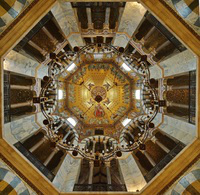Speaker
Description
Positronium and muonium, being purely leptonic, are very interesting systems to test bound state QED free of finite size effects and hadronic corrections [1]. They are also very sensitive probes to search for New Physics [2] and can be used to extract fundamental constants such as the muon mass and magnetic moment [3].
In this talk, we report the current status of the ongoing experiment at ETH Zurich [4] aiming to improve the accuracy on the 1S-2S transition frequency of positronium in order to cross check the latest QED calculations [5]. We will present some preliminary results including the technique we developed to correct for the second order Doppler shift, the main systematic uncertainty in this experiment.
We will show that with the recent advances in UV laser technology, our novel cryogenic muonium converters and the detection techniques we developed for positronium spectroscopy, a 1000-fold improvement in the determination of the same transition in muonium compared to the current results [6] will be possible using the LEM beamline at PSI. This will provide the best determination of the muon mass at the 1 ppt level. It can also be used to extract the muon g-2 from the ongoing experiment at Fermilab which have a projected accuracy of 0.1 ppm [7] . In fact at this level, the comparison with the theoretical value will be limited by the current knowledge of the muon magnetic moment or the muon mass.
Moreover, by using the expected results of the ongoing hyperfine splitting measurement of muonium in Japan at JPARC [8], it will provide one of the most sensitive tests of bound-state Quantum Electrodynamics. It will also allow to determine the Rydberg constant free from nuclear and finite-size effects at a level of 10$^{-12}$ which is interesting in light of the proton charge radius puzzle [9] and provide a new determination of the fine structure constant at a level of 1 ppb. This has to be compared with the electron g-2 experiment at Harvard (0.24 ppb) [10], the Rubidium experiment at Laboratoire Kastler Brossel (0.62 ppb) [11] and the very recent experiment using matter-wave interferometry with a cloud of cesium atoms (0.12 ppb) [12].
\setlength\parindent{0pt}\vspace{2ex}
\textbf{References}\par
\footnotesize
\vspace{0.5cm}
[1] S.. Karshenboim,Phys. Rep. {\bf 422}, 1 (2005).
[2] see e.g. L. Willmann et al., Phys. Rev. Lett. {\bf 82}, 49 (1999); A. Badertscher et al., Phys. Rev. D {\bf 75}, 032004 (2007).
[3] P. J. Mohr, D. B. Newell and B. N. Taylor, Rev. Mod. Phys. {\bf 88}, 035009 (2016).
[4] D. Cooke et al., Hyperfine Int. {\bf 233}, 67 (2015).
[5] G. S. Adkins et al., Phys. Rev. Lett. {\bf 115} 233401 (2015) and references therein
[6] V. Meyer et al., Phys Rev. Lett. {\bf 84}, 1136 (2000).
[7] W.~Gohn, FERMILAB-CONF-17-602-PPD, arXiv:1801.00084 [hep-ex].
[8] P. Strasser et al., Hyperfine Interact. {\bf 237}, 124 (2016).
[9] R. Pohl et al., Nature 466, {\bf213} (2010); A. Antognini et al., Science {\bf339}, 417 (2013).
[10] B. Rym et al., Phys. Rev. Lett. {\bf106} 080801 (2010).
[11] D. Hanneke, S. Fogwell, and G. Gabrielse, Phys. Rev. Lett. {\bf 100}, 120801 (2008).
[12] R. H. Parker et al. Science 360, 191 (2018)
